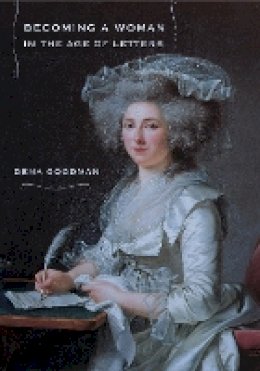12%OFF
Stock image for illustration purposes only - book cover, edition or condition may vary.
Becoming a Woman in the Age of Letters
Dena Goodman
FREE Delivery in Ireland
Description for Becoming a Woman in the Age of Letters
Paperback. Num Pages: 408 pages, 108. BIC Classification: 2ADF; DSBD. Category: (UP) Postgraduate, Research & Scholarly. Dimension: 179 x 254 x 19. Weight in Grams: 736.
Over the course of the eighteenth century, increasing numbers of French women, from the wives and daughters of artisans and merchants to countesses and queens, became writers-not authors, and not mere signers of names, but writers of letters. Taking as her inspiration a portrait of an unknown woman writing a letter to her children by French painter Adélaïde Labille-Guiard, Dena Goodman challenges the deep-seated association of women with love letters and proposes a counternarrative of young women struggling with the challenges of the modern world through the mediation of writing. In Becoming a Woman in the Age of Letters, Goodman ... Read moreenters the lives and world of these women, drawing on their letters, the cultural history of language and education, and the material culture of letter writing itself: inkstands, desks, and writing paper.
Goodman follows the lives of elite women from childhood through their education in traditional convents and modern private schools and into the shops and interior spaces in which epistolary furnishings and furniture were made for, sold to, and used by women who took pen in hand. Stationers set up fashionable shops, merchants developed lines of small writing desks, and the furnishings and floor plans of homes changed to accommodate women's needs. It was as writers and consumers that women entered not only shops but also the modern world that was taking shape in Paris and other cities.
Although many women, from major novelists, painters, and educators to schoolgirls and their mothers as well as Parisian tourists and other shoppers, come to life in this book, Goodman focuses on four bodies of epistolary work by little-known women: the letters of Genevieve de Malboissiére, Manon Phlipon, Catherine de Saint-Pierre, and Sophie Silvestre. These letters allow Goodman to explore how particular girls of different social positions came to womanhood through letter writing. She shows how letter writing expanded women's horizons even as it deepened their ability to reflect on themselves.
The analysis of more than one hundred illustrations—from paintings by major Dutch and French artists to inkstands and writing desks, stationers' trade cards, and manuscript letters on decorated paper—is integral to Goodman's argument.
Show Less
Product Details
Publisher
Cornell University Press United States
Place of Publication
Ithaca, United States
Shipping Time
Usually ships in 7 to 11 working days
About Dena Goodman
Dena Goodman is Lila Miller Collegiate Professor of History and Women's Studies at the University of Michigan. She is the author of The Republic of Letters: A Cultural History of the French Enlightenment and Criticism in Action: Enlightenment Experiments in Political Writing, both from Cornell, and the editor or coeditor of several other books including, most recently, Furnishing the Eighteenth ... Read moreCentury. Show Less
Reviews for Becoming a Woman in the Age of Letters
"From paintings and novels through paper, ink, and exquisite desks to the words of women who poured their hearts out to each other, Dena Goodman takes us on a dazzling tour of the world of eighteenth-century female letter-writers. Goodman makes a convincing case that these French women did not just record their thoughts on paper; they invented their very selves ... Read morethrough the rituals and pleasures of correspondence."
Sarah Maza, Jane Long Professor of Arts and Sciences, Northwestern University "Reading Dena Goodman's creative exploration of French culture and gender history is always a treat. In Becoming a Woman in the Age of Letters, Goodman turns her attention to the iconic Enlightenment practice of letter writing and plunges deep into the intimate material details of how four particular women in eighteenth-century France experienced the culture of reading and writing letters. Interpreting a broad variety of cultural artifacts from portraits of female letter writers to letter-writing manuals, inkwells, stationery, and writing desks, Goodman reveals a detailed picture of how female letter writers participated in both the burgeoning material and consumer culture of eighteenth-century France and the domestic sphere of family and friendship. Engaging an important set of questions in both cultural studies and feminist historiography about subjectivity, empowerment, and writing, Goodman argues that women experienced writing as an activity that both provided an autonomous space for self-reflection and control and a connected space in which they enacted identities as mothers, daughters, and female friends."
Jennifer Jones, Rutgers, The State University of New Jersey "This wonderful book is essential reading for anyone interested in women and the Enlightenment. Dena Goodman brings together diverse areas of inquiry to focus on the issue of letter writing and its role in the formation of a woman's sense of self in eighteenth-century France. Becoming a Woman in the Age of Letters, which is based on truly impressive original research, is written in an elegant, accessible style."
Mary Sheriff, W. R. Kenan, Jr., Distinguished Professor of Art History, The University of North Carolina at Chapel Hill "We might expect a book on girls and young women writing letters to tell us about their education and the instruction given by their mothers, but Dena Goodman takes us to many more surprising places too: to the shops where inkstands, fine Dutch paper, and fashionable writing desks were sold, to female painters choosing how to depict women writing letters, and ultimately to the hard-won sense of self gained in the act of pressing quill to paper. Goodman recaptures a world we have forgotten and recovers aspects of it we never knew."
Lynn Hunt, Eugen Weber Professor of Modern European History, UCLA, author of Inventing Human Rights Show Less

